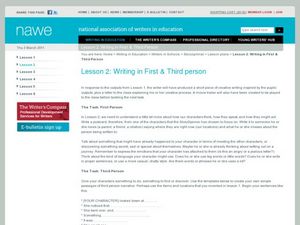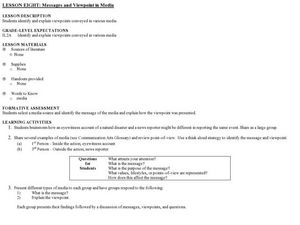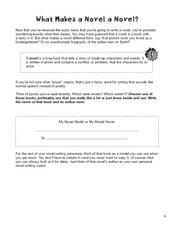K12 Reader
Change the Point of View: First Person and Third Person
How is a story different when told from various points of view? Learn about first and third person points of view with an activity based on Robert Louis Stevenson's Treasure Island. Readers examine a passage written in first person, then...
K12 Reader
Point of View: Who Is Telling the Story?
See how famous books of literature have different perspectives with a short worksheet. After reviewing the difference between first and third person points of view, learners look over six passages from various novels and decide which...
K12 Reader
Change the Point of View: Third Person to First Person
Use Jack London's The Call of the Wild to help young writers learn the difference between first and third person points of view. After they read a passage from the novel, they rewrite it in the first person point of view.
PBS
The Power of Personal Narrative
Personal narratives are powerful things. Whether told from the first-person or third-person point of view, whether in the form of an essay, a short story, novel, or video, whether fiction or fact, they capture readers and give them...
Curated OER
Writing in First and Third Person
Explore narrative writing by participating in a role-playing activity. In this perspective lesson plan, learners define first and third person in writing and discuss how it changes the mood of the reader. The first activity has pupils...
Curated OER
Marking Time
Two narrative excerpts tell the same story from different points of view. In the first excerpt (first person), sequencing words and phrases are bolded and learners write down what the bold type does. The second excerpt is in third...
Curated OER
Faulkner's The Sound and the Fury: April Eighth, 1928: Narrating from an 'Ordered Place'?
High schoolers analyze a character of Faulkner's The Sound and the Fury to catch a glimpse of a family and the changes they, and the Old South, undergo. The use of time as it relates to the structure of the plot is covered in this...
Curated OER
Third Person Point of View
Have your class practice determining whose point of view is being utilized throughout the course of a story. They begin by working as a class to create a chart which will provide textual examples that describe first and third person...
K12 Reader
Narrator and Point of View
Point of view is important when choosing a narrator. Help young writers distinguish between first and third person point of view with an activity that features excerpts from Robert Louis Stevenson's Treasure Island. After reading four...
K12 Reader
Narrator’s Point of View Flow Chart
How can you tell what point of view a narrator is using, and why does it matter when reading or writing? Use a handy flow chart to determine whether or not your narrator is telling the story from a first or third person point of view.
EngageNY
Analyzing Point of View: Inferring about the Natural Disaster in Eight Days
Who is telling the story? Readers take a look at the text Eight Days to determine if the story is told in first or third person. They then discuss in groups and complete a shared writing activity to describe how the narrator's point of...
English Worksheets Land
Identifying Narrative Perspective
First and third person points of view are the focus of a worksheet that has four practice passages that allow learners to identify the appropriate perspective. Then, they must respond and explain how they know.
Curated OER
What's the Point of View?
Sixth graders explain what a point of view is. They list two different types of examples of third person point of view and identify the difference between a third person limited and third person omniscient . Additionally, they read a...
Curated OER
Messages and Viewpoint in Media
Explore media point of view. In this literacy and current events lesson, pupils identify examples of first and third person point of view in media articles. They analyze examples of media, interpret the messages, and determine purposes...
Curated OER
Identifying Narrative Perspective 4
In this narrative perspective worksheet, students identify the narrative perspective of paragraphs read including first, second, third person, and more. Students complete 9 problems.
Curated OER
Subjective Pronouns
In this subjective pronouns worksheet, students determine singular and plural pronouns referring to first person, second person, and third person nouns. Students complete fifteen activities.
Curated OER
Grammatical Person: 1st, 2nd, and 3rd Person
In this grammatical person: first, second, and third person worksheet, learners determine the speaker/participants relationship. Students use a chart to identify grammatical person in seventeen sentences.
Curated OER
Personal Pronouns: Putting It All Together
In this personal pronouns worksheet, students fill in 10 fill in the blank answers about personal pronouns and choose which multiple choice pronoun in parentheses correctly completes 8 sentences. Students practice using the pronouns I or...
EngageNY
Writing Narratives from First Person Point of View: Imagining Meg Lowman’s Rainforest Journal
I spy with my little eye! Learners observe page 23 in The Most Beautiful Roof in the World and practice what they would add to a field journal. They discuss how details from the text help add to their thoughts. To finish, readers use...
Houghton Mifflin Harcourt
Person to Person: Extra Support Lessons (Theme 4)
Authors use many strategies when writing stories. A series of extra support lessons breaks down those strategies, as well as key grammatical and phonics-based concepts to support struggling learners. The last of three lessons offers...
Curated OER
What Makes a Novel a Novel?
As your authors prepare to write a hypothetical novel, they need all the inspiration they can find! Using a book they have already read (and enjoyed), learners complete a literary analysis by filling in eight short-answer questions....
Curated OER
Speaker, Speaker: Using Pronouns to Show Person
In this pronouns activity, students fill in 12 blanks completing 7 facts about pronouns, read 8 sentences and determine if the underlined pronoun in each sentence is told in first, second or third person.
K12 Reader
Personal Pronouns
Practice personal pronouns with a special focus on subject and object pronouns. Learners read 20 sentences and circle the subject or object pronoun in each. They note which is present with an S or an O.
Manchester College
What’s Your Point of View?
Work on deciphering the point of view of various pieces of literature. As readers review the concepts of first, second, and third person perspective, they apply what they know to different passages.

























